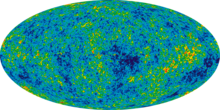| Part of a series on |
| Physical cosmology |
|---|
 |
In cosmology, decoupling is a period in the development of the universe when different types of particles fall out of thermal equilibrium with each other. This occurs as a result of the expansion of the universe, as their interaction rates decrease (and mean free paths increase) up to this critical point. The two verified instances of decoupling since the Big Bang which are most often discussed are photon decoupling and neutrino decoupling, as these led to the cosmic microwave background and cosmic neutrino background, respectively.
Photon decoupling is closely related to recombination, which occurred about 378,000 years after the Big Bang (at a redshift of z = 1100), when the universe was a hot opaque ("foggy") plasma. During recombination, free electrons became bound to protons (hydrogen nuclei) to form neutral hydrogen atoms. Because direct recombinations to the ground state (lowest energy) of hydrogen are very inefficient, these hydrogen atoms generally form with the electrons in a high energy state, and the electrons quickly transition to their low energy state by emitting photons. Because the neutral hydrogen that formed was transparent to light, those photons which were not captured by other hydrogen atoms were able, for the first time in the history of the universe, to travel long distances. They can still be detected today, although they now appear as radio waves, and form the cosmic microwave background ("CMB"). They reveal crucial clues about how the universe formed.
© MMXXIII Rich X Search. We shall prevail. All rights reserved. Rich X Search
